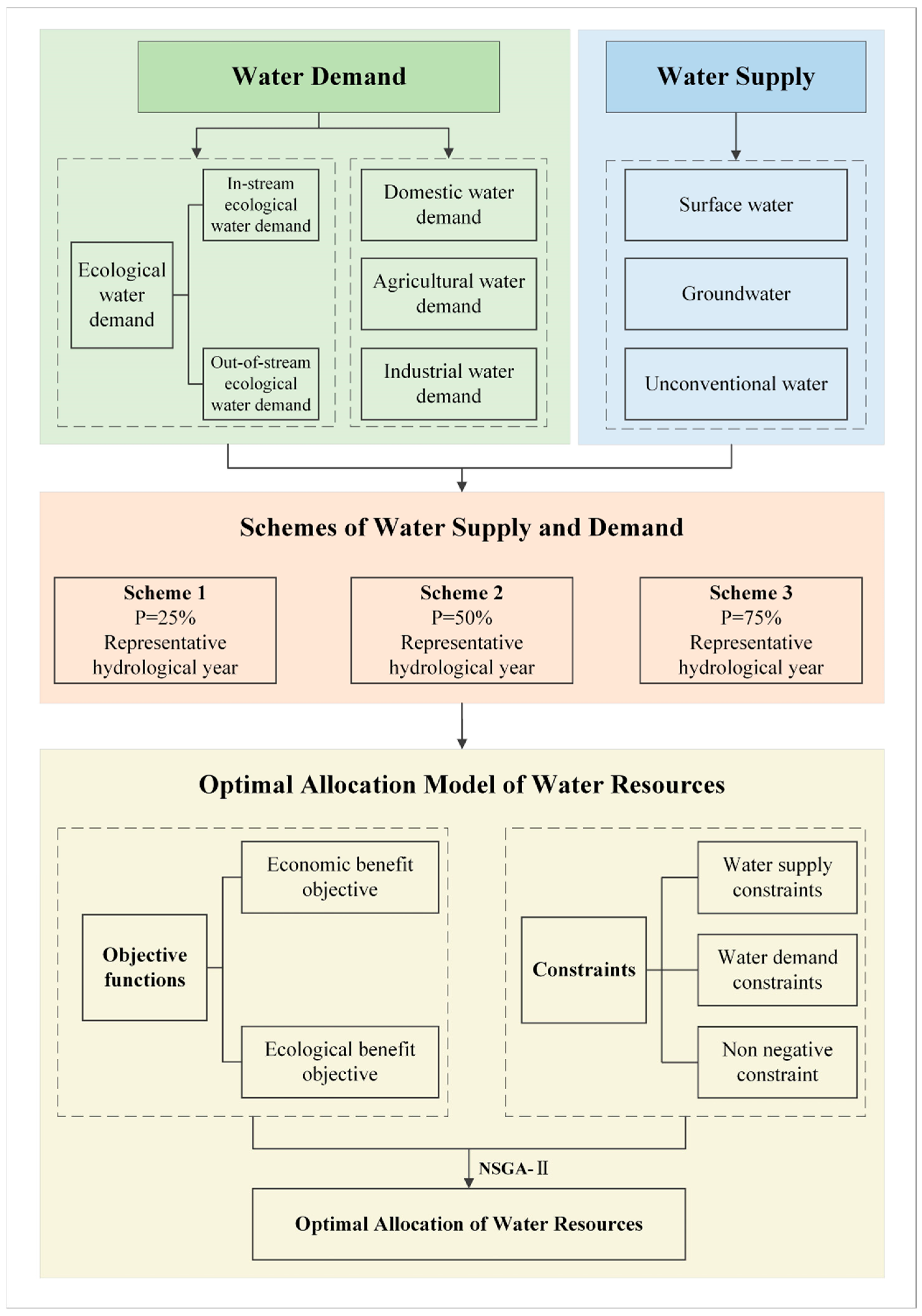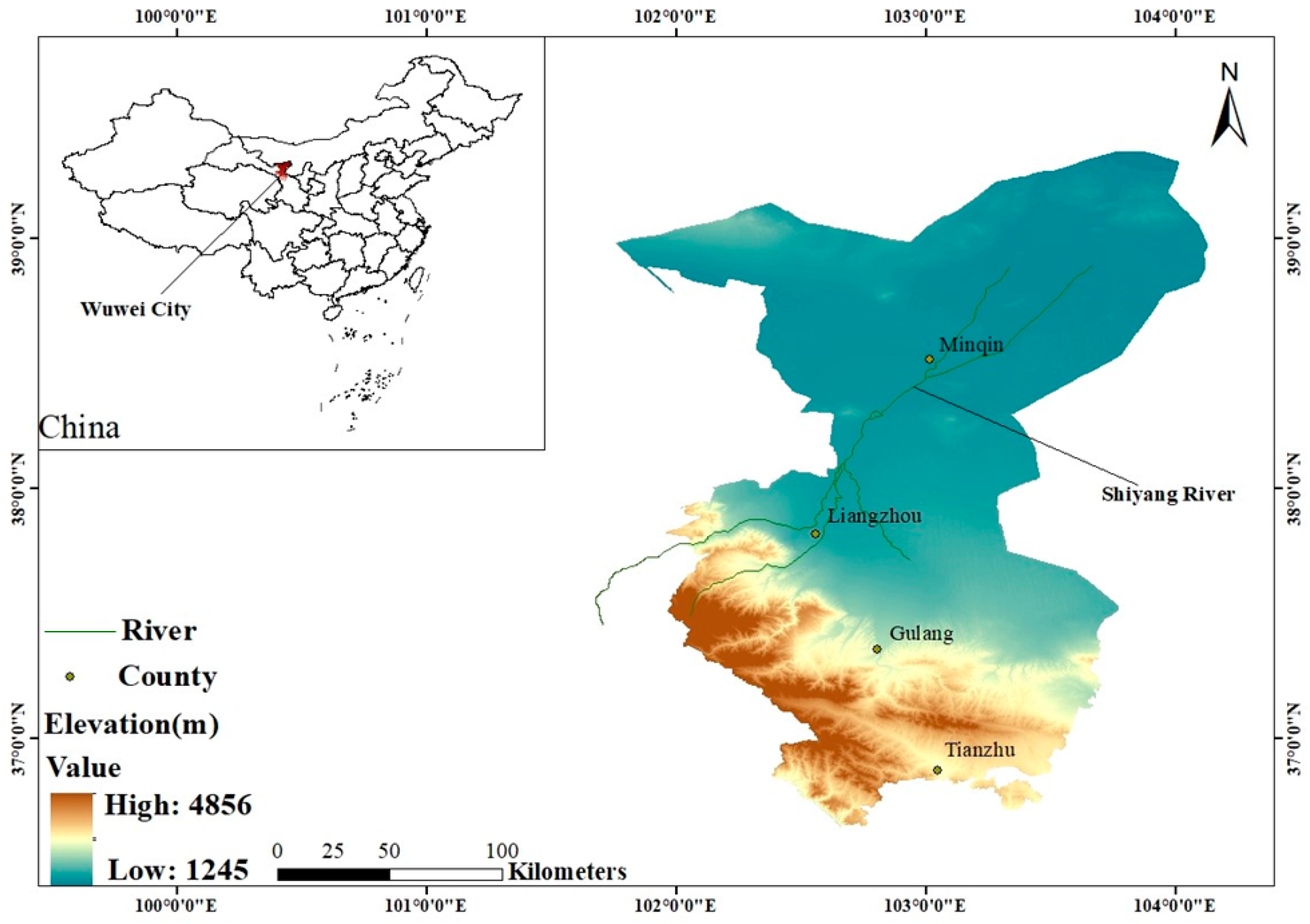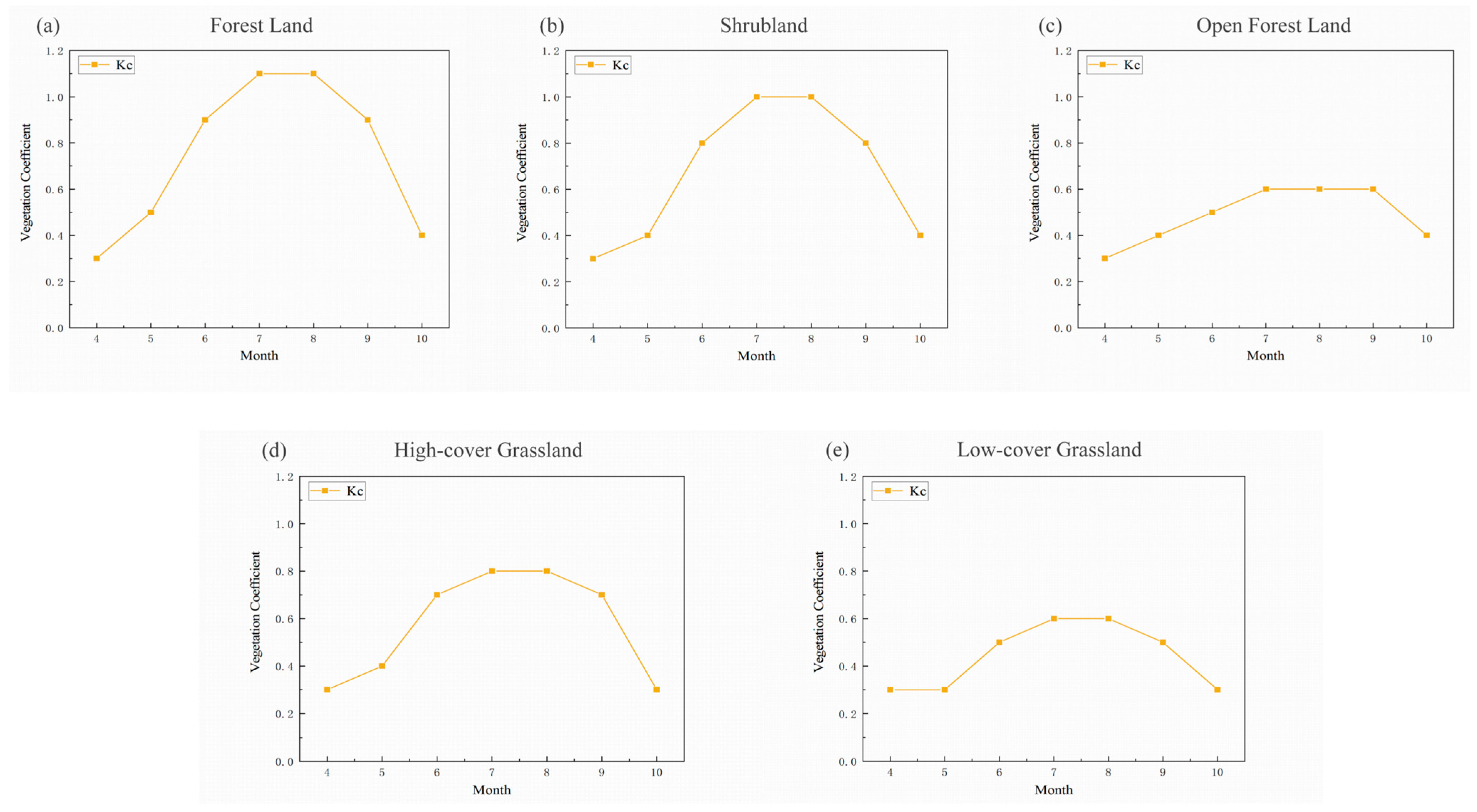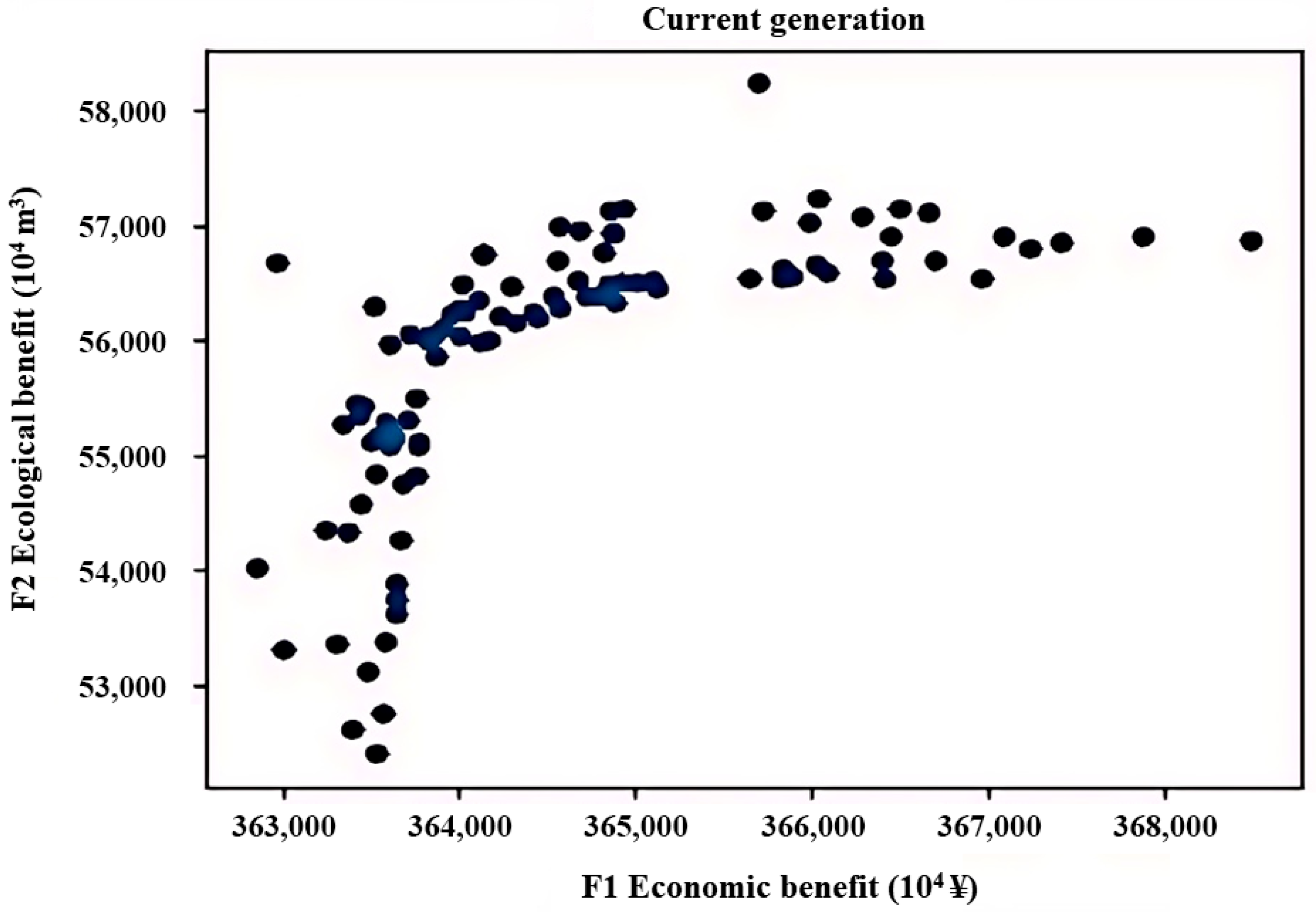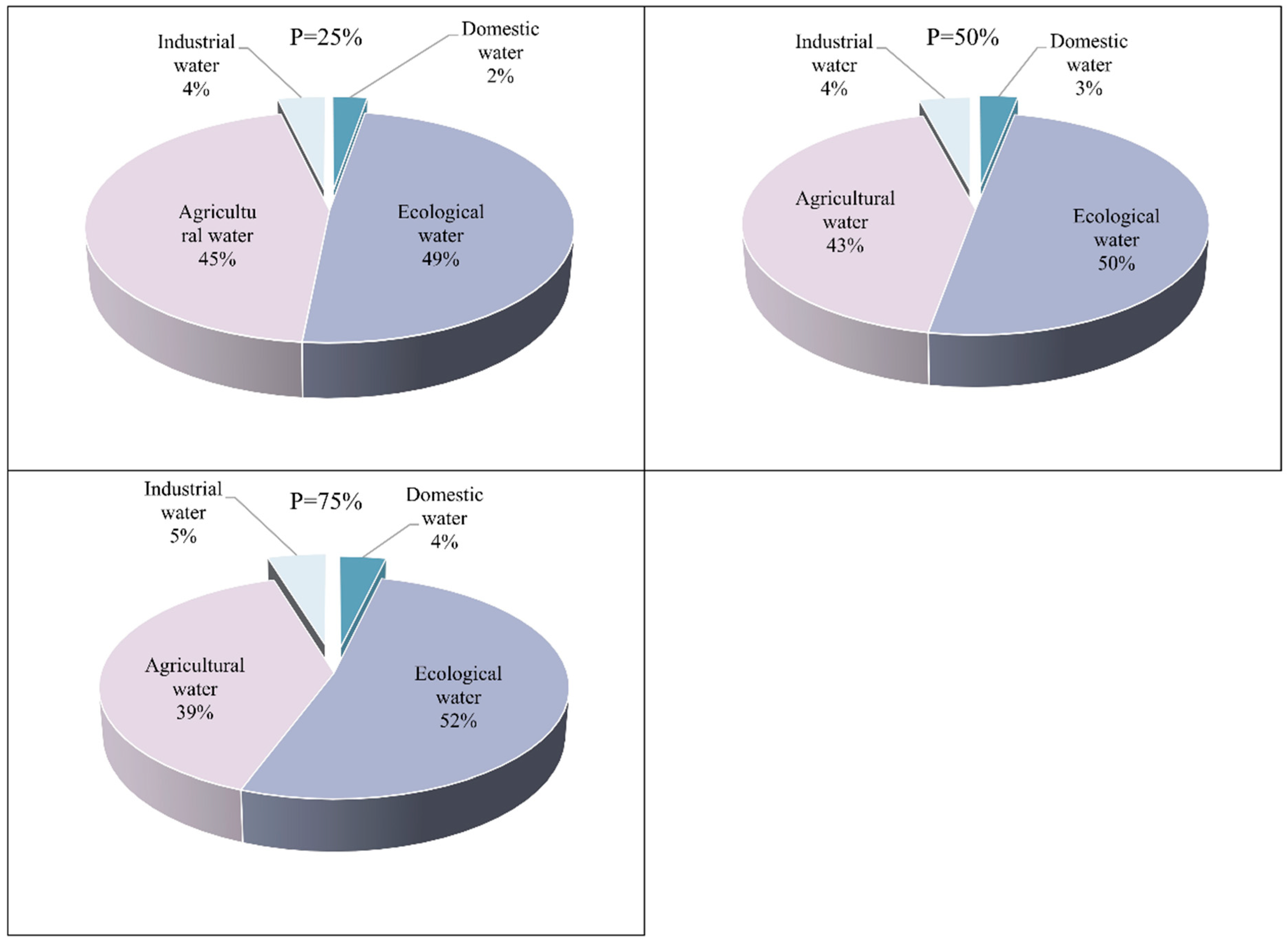1. Introduction
Water, being one of the most vital resources for human existence and growth, plays a significant part in the development of social economy. At the same time, the value of water resources is obvious given its ecological, social, and economic functions [
1]. In addition, as the population and social economy grow, so does the demand for water supplies [
2,
3]. Furthermore, the unequal geographical and temporal distribution of water resources, as well as inappropriate development and usage, have resulted in a constant escalation of the conflict between water supply and demand, compounding the water scarcity situation. And water resources scarcity would not only impede the continued growth of the social economy, but it would also make other water-using sectors occupy ecological water, severely limiting the healthy development of the ecological environment [
4]. Therefore, the study on optimal allocation of water resources, taking ecological water resources demand into consideration, is of great significance to the sustainable development of regional water resources and ecological environment.
In past studies, water resources allocation has mostly focused on enhancing economic benefit, while paying little attention to ecological environment [
5,
6,
7,
8]. For example, Valipour et al. [
9] developed an integrated optimization framework that, while incorporating the Gini coefficient and modifying the Bentham–Rawls criterion, enables maximization of economic benefits in coastal groundwater resource allocation, through which both efficiency and equity objectives are systematically addressed. Moghani and Karami [
10] utilize the flow direction algorithm to optimize water resource allocation, achieving maximum economic benefits in hydropower generation. Wang et al. [
11] employed the multi-objective nutcracker optimization algorithm to optimize water resources allocation in Handan city, focusing primarily on economic benefits while lacking comprehensive consideration of ecological factors. However, as the ecological environment deteriorates and the decision maker’s design requirements increase, the water resources allocation method that just considers social and economic benefits can no longer meet current needs.
In order to deal with the above issues, many scholars have performed a series of studies on optimization allocation of water resources that take ecological water demand into consideration [
12,
13,
14]. For example, Najafabadi et al. [
15] considered the balance between agricultural production and sustainable water resources based on meta-goal programming methodology, which resulted in an optimal model of agricultural cultivation. Yazdian et al. [
16] integrated macroinvertebrate diversity indices into reservoir operation optimization to balance ecological flows and water supply demands. Chu et al. [
17] developed a multi-objective nutcracker optimization algorithm to optimize water resources allocation with ecological water demands prioritized in the Lower Fen River Basin, achieving balanced allocation among social, economic, and ecological objectives. Although ecological water demand was taken into consideration in the above studies, its computation was relatively simple, especially in some studies which just estimated an ecological water demand value. According to present studies, accurately calculating ecological water demand is critical to the sustainable development of the regional ecological environment, as well as the foundation for allocating and utilizing regional water resources.
Recently, a series of studies have been made on ecological water demand, with the Tennant method being the most generally utilized [
18,
19]. It can evaluate the ecological water demand based on the average value of stream flow and deal with the influence of seasonality of stream flow on ecological water demand. However, the traditional Tennant method cannot take into account the changes in ecological water demand processes, resulting in an overestimation of ecological water demand. As a result, the improved Tennant’s method was obtained by selecting a typical year, introducing a seasonal correction coefficient, and determining the ecological water demand using median streamflow value as the required value [
20]. Therefore, this study investigates the optimal allocation of water resources based on ecological water demand, which adopts the improved Tennant method to determine accurate ecological water demand values and follows the principle of ecological water use priority in the process of water resources distribution.
In addition, the optimal allocation of water resources is a typical multi-objective, group decision-making problem that involves social, economic, ecological, and other factors [
21,
22,
23]. For example, Tekle et al. [
24] developed a multi-objective optimization framework by coupling simulation models with optimization algorithms, which effectively optimizes water resource allocation while balancing fairness, economic benefits, and shortage risk. Park and Bayraksan [
25] employed a multistage distributionally robust optimization method with moment-based ambiguity sets to address water resource allocation under climate uncertainty, achieving optimal solutions through a tailored decomposition algorithm. Xu et al. [
26] applied an improved decomposition and dynamic programming aggregation method to optimize water resource allocation in in-series reservoirs through mathematical modeling, achieving better global optimization results than heuristic algorithms. However, while dealing with multi-objective issues, the traditional approach is to convert multiple objectives into a single objective for solution. And the optimization scheme obtained by the above method are frequently intimately tied to the decision maker’s subjective intent, making it difficult to obtain a more objective optimization scheme. As a result, in recent years, most scholars have used intelligent bionic algorithms to deal with multi-objective water resources optimization allocation, such as the genetic algorithm [
27], fish swarm algorithm [
28], whale algorithm [
29], and the cheetah optimizer [
30]. Among them, NSGA-Ⅱ (the second-generation non-dominated sorting genetic algorithm) [
31] is one of the most widely used methods in multi-objective genetic algorithms. It is a multi-objective optimization algorithm that seeks the Pareto optimal solution set of the problem through a genetic algorithm; it finally obtains a Pareto optimal solution set by adopting the methods of non-dominated sorting and crowding sorting to maintain the population diversity and generating the next generation of individuals through crossover and mutation operations. During the operation of NSGA-Ⅱ, by simulating the niche allocation mechanism and selecting the tournament selection method, as well as the non-dominated sorting and crowding sorting results, the diversity and uniform distribution of a solution in the population are ensured, and individuals with stronger adaptability are selected for reproduction [
32,
33]. As a result, it can effectively search for solutions to multi-objective optimization problems and provide a set of Pareto optimal solutions, providing decision makers with options for determining the best trade-offs between multiple objectives. Therefore, this study adopts NSGA-Ⅱ algorithm to deal with the multi-objective programming issue in the optimal allocation of water resources.
In summary, since traditional water resources allocation frequently takes maximum economic benefit as its primary objective, and often ignores ecological benefits, or only just estimates an ecological water demand value, this study developed a multi-objective water resources optimization allocation model based on ecological water demand, which adopts the improved Tennant method to determine accurate ecological water demand values and follows the principle of ecological water use priority in the process of water resources allocation. In addition, the developed multi-objective model was applied to Wuwei city, Gansu Province, China, which had maximum economic and ecological benefits as objectives. In addition, with screening of the optimal solution set derived by using NSGA-II algorithm to deal with the proposed multi-objective model, optimal allocation schemes of water resources under different representative hydrological years can be offered.
4. Results and Discussion
According to the water scarcity and ecological environment deterioration in Wuwei City, a multi-objective water resources optimization allocation model based on ecological water demand was established, which makes economic benefit maximization and ecological benefit maximization as objectives and water supply, water demand, and food security as constraints. And the NSGA-Ⅱ algorithm is employed to solve the established multi-objective model. Initially, the population size and number of generations have been set as 100 and 2, respectively. Moreover, in the calculation, crossover and mutation rate are not assigned exact values. Specifically, when generating a new population, the code executes a crossover operation for each parental couple, followed by a mutation subsequent to the crossover, which can guarantee that the population consistently engages in extensive exploration, hence avoiding premature convergence. During the solution process, the Pareto front solution set can be obtained, as shown in
Figure 5, which demonstrates the distribution of solutions for different optimization objectives and provides exact values of decision variables relevant to economic and ecological benefits.
Furthermore, based on the obtained optimal solutions, the TOPSIS method and the comprehensive weight method [
64] are utilized to assess each optimal allocation scheme, and the best optimal allocation scheme under different representative hydrological years can be obtained, as presented in
Table 9,
Table 10 and
Table 11.
Figure 6 represents the water distribution for each water-using sector in different subareas under different representative hydrological years.
Figure 6 represents water resources optimization allocation among different water use sectors in different sub-districts of Wuwei city under different representative hydrological years. From figure, the water resources consumption among different water use sectors in different sub-districts vary as representative hydrological years changes. For example, when
p changes from 25% to 75%, the agricultural water resources consumption in Liangzhou, Minqin, Gulang, and Tianzhu, changes from 5.26 × 10
8 m
3 to 2.22 × 10
8 m
3, 1.18 × 10
8 m
3 to 1.03 × 10
8 m
3, 1.58 × 10
8 m
3 to 1.61 × 10
8 m
3, and 1.03 × 10
8 m
3 to 0.51 × 10
8 m
3, respectively. Moreover, as representative hydrological years changes, the water resources consumption in the same sub-district is significantly different. For example, as
p changes from 25% to 75%, the total water resources consumption in Liangzhou and Tianzhu changes from 6.96 × 10
8 m
3 to 3.79 × 10
8 m
3 and 8.67 × 10
8 m
3 to 5.48 × 10
8 m
3, respectively.
In addition, the total water resources consumption among different sub-districts represents significant differences under the same representative hydrological years. For example, when
p = 25%, the total water resources consumption in Liangzhou, Minqin, Gulang, and Tianzhu are 6.96 × 10
8 m
3, 2.10 × 10
8 m
3, 2.49 × 10
8 m
3, and 8.67 × 10
8 m
3, respectively. From the above results, Liangzhou and Tianzhu’s water resources consumption are relatively high, accounting for 27.93% and 40.38% of total water resources consumption of Wuwei. For Liangzhou, as the key agricultural production area in Gansu Province, as well as a major grain-production area in China, the agricultural water resources consumption is always high. Tianzhu, on the other hand, due to its large areas of shrubland, open forest land, high-cover grassland, and mid-cover grassland, accounts for 89.07% of Wuwei city’s total vegetation ecological water resources demand, as shown in
Table 5. Consequently, there are great differences in water resources consumption among different sub-districts under the same representative hydrological years.
Furthermore, under the same representative hydrological years, the water resources consumption in the same water use sectors of different sub-districts also shows great difference. For example, when p = 50%, domestic water resources consumption in the four sub-districts are 0.29 × 108 m3, 0.07 × 108 m3, 0.09 × 108 m3, and 0.05 × 108 m3; agricultural water resources consumption in the four sub-districts are 3.57 × 108 m3, 0.80 × 108 m3, 1.50 × 108 m3, and 1.00 × 108 m3; ecological water resources consumption in the four sub-districts are 0.81 × 108 m3, 0.92 × 108 m3, 0.47 × 108 m3, and 5.73 × 108 m3; and industrial water resources consumption in the four sub-districts are 0.48 × 108 m3, 0.08 × 108 m3, 0.08 × 108 m3, and 0.02 × 108 m3, respectively. Based on the above results, Liangzhou has the largest domestic water consumption, yet the variation across sub-districts is not significant, which is mainly because domestic water consumption is directly proportional to population size. Although Liangzhou has the greatest population, there is not a significant variation in population size within sub-districts. Compared to the other three sub-districts, Tianzhu has a much greater ecological water resources consumption. This is mostly due to Tianzhu’s extensive natural vegetation which includes shrubland, open forest land, high-cover grassland, and mid-cover grassland, all of which contribute to the vegetation’s enormous ecological water demand. For agricultural water resources consumption, Liangzhou is much higher than the other sub-districts, yet there is no obvious distinction between the three. The primary reason is because Liangzhou, Wuwei’s primary grain-producing region, has a much larger cultivated land area than other regions. In general, the sub-districts’ industrial water resources consumption is rather low, with minimal variation among them, of which Liangzhou has the largest industrial water resources consumption. This is mainly because Wuwei is an agricultural city with heavy water resources consumption and the proportion of industry is very small. As a result, there is minimal variation throughout the sub-districts and a comparatively low industrial water resources consumption.
Figure 6 also depicts the composition of water resources consumption by water use sectors in various sub-districts under different representative hydrological years. Because other water resources use recycled water and the quantity is very small, it is only distributed to ecological water according to the requirement and principles of optimal allocation of water resources. From figure, regardless of the representative hydrological years, Liangzhou and Minqin’s water supply are primarily groundwater resources, whereas Gulang and Tianzhu’s are primarily surface water resources. For example, when
p = 50%, the surface water resources and groundwater resources consumed by Liangzhou and Minqin are 1.62 × 10
8 m
3, 3.49 × 10
8 m
3, 0.59 × 10
8 m
3, and 1.24 × 10
8 m
3, respectively, whereas Gulang and Tianzhu consume 1.90 × 10
8 m
3, 0.23 × 10
8 m
3, 6.59 × 10
8 m
3, and 0.17 × 10
8 m
3. This is mainly because the focus of the paper is to investigate the optimal allocation of water resources to meet ecological water demands. As a result, during the purpose of water resources optimization, domestic water use is prioritized, followed by ecological water use, and the remaining water resources are assigned to other industries. In addition, the basis of water supply is firstly surface water resources, then groundwater resources, and other water resources such as recycled water resources, which are limited in quantity and assigned to ecological water.
Moreover,
Figure 6 shows that groundwater resources account for a considerable share of Liangzhou’s agricultural water consumption. For example, when
p = 25%, the proportion of groundwater resources in agricultural water consumption is 54.75%. In addition, when
p rises from 25% to 75%, the proportion of groundwater resources in agricultural water consumption increases from 54.75% to 95.95%. The reason is similar to those described above. Furthermore, when
p rises from 25% to 75%, the amount of available surface water resources decreases from 3.41 × 10
8 m
3 to 0.24 × 10
8 m
3. At the same time, Liangzhou has the lowest unit water resources net benefit coefficient. As a result, groundwater resources account for a significant share of agricultural water consumption in Liangzhou, and the proportion grows as
p increases.
Figure 7 shows the proportion of water resources consumption of different water-using sectors in Wuwei city under different representative hydrological years. From figure, regardless of the representative hydrological year, agricultural and ecological water use are the main water-consuming sectors in Wuwei city, accounting for more than 90%. For example, the proportion is 94% when
p = 25%, 93% when
p = 50%, and 91% when
p = 75%. This is primarily because Wuwei city is an agricultural city based on heavy water consumption; therefore, optimal allocation of water resources requires a considerable quantity of water resources to ensure minimal food safety production. Moreover, since it is an agricultural city, the residual water resources after fulfilling the water demand of other industries would continue to be distributed to agriculture to assure the local farmers’ benefits. In addition, ecological water use in Wuwei city is always occupied by economic water use, resulting in a decrease in ecosystem service functions. For dealing with the above issue, based on the obtained actual ecological water demand, during the water resources optimization allocation process, ecological water use was prioritized after domestic water use, and its demand was satisfied. As a result, the proportion of ecological water consumption was quite high, reflecting the priority concept stated when developing a multi-objective optimization allocation model of water resources based on ecological water demand.
Furthermore, when the representative hydrological years changes, the proportion of agricultural and ecological water consumption varies to some amount. For example, when p rises from 25% to 75%, the percentage of ecological water consumption rises from 48.90% to 52.00%, while agricultural water consumption decreases from 44.80% to 39.60%. This is mainly because, when p changes from 25% to 75%, the amount of available surface water resources decreases, and in the process of optimal allocation of water resources, ecological water consumption must be prioritized while domestic water consumption is maintained. As a result, as available water resources decrease and ecological water consumption remains relatively constant, agricultural water consumption would decrease. Therefore, as shown in the overall proportion of water resources consumption, agricultural water consumption declines while ecological water consumption increases, when p changes from 25% to 75%.
In addition,
Figure 6 also shows that industrial and domestic water consumption account for just a minor amount. This is mostly because domestic water consumption is proportional to population size. As a result, the domestic water consumption remains basically unchanged under different representative hydrological years; however, as
p increases from
p = 25% to
p = 75%, the available water resources decrease, resulting in an increase in the proportion of domestic water consumption, even though it remains essentially unchanged. And for industrial water consumption, the principle is similar.
Table 11 represents the water shortage rates of Wuwei city’s various water-using sectors under different representative hydrological years. From
Table 11, the domestic water shortage rate is 0% under different representative hydrological years. This is primarily because, while developing the multi-objectives model, the principle of prioritizing and assuring domestic water consumption is adopted, which is also consistent with the real scenario. However, the ecological, agricultural, and industrial sectors all face variable degrees of water scarcity, and the severity of the scarcity grows as
p increases. For example, as
p rises from 25% to 75%, the water shortage rates in ecology, agriculture, and industry increase from 21.34% to 43.87%, 11% to 47.15%, and 15.91% to 27.27%, respectively. From the above results, this shows that Wuwei city is experiencing a severe water deficit, and water resources have become one of the important factors restricting the sustainable development of Wuwei city. In addition, although the ecological water shortage rate rises with increasing
p, ecological water consumption remains the largest. This demonstrates that when allocating water resources based on the multi-objective optimization allocation model of ecological water demand, although it is difficult to meet the optimal ecological water demand, it can allocate as many water resources as feasible to the ecological sector while meeting the minimum ecological water demand.
In the process of dealing with the developed multi-objective model, the optimal results of the single objective can be obtained, which just made maximum economic benefit and maximum ecological benefit as objectives, respectively. And
Table 12,
Table 13 and
Table 14 represent water supply net benefit and ecological water deficit under maximum water supply net benefit objective, maximum ecological benefit objective, and multi-objectives in different representative hydrological years, respectively. From tables, regardless of the optimization objective, the water supply net benefit and ecological water deficit changes as
p changes. In general, as
p increases from 25% to 75%, water supply net benefit and ecological water deficit have significant increase and decrease tendencies, respectively. This is primarily because when
p changes from 25% to 75%, that is, the representative hydrological year changes from wet to dry, there is a significant decrease in available surface water resources. As a result, in addition to domestic water consumption, water allocation to other sectors is reduced accordingly, reducing the net benefit of water supply substantially. For ecological water consumption, although the principle of prioritizing ecological water is followed, the water requirement of other industries would still be considered when optimizing allocation of water resources, particularly when available water resources are reduced, so the ecological water deficit increases as
p from 25% to 75%. For example, under maximum ecological benefit, the ecological water deficit grows from 2.45 × 10
8 m
3 to 5.36 × 10
8 m
3.
However, there were differences in water supply net benefit and ecological water deficit in three different objectives. From
Table 12,
Table 13 and
Table 14, when comparing water supply net benefit and ecological water deficit under three different objectives, the water supply net benefit and ecological water deficit of the maximum economic benefit objective are the largest under the same representative hydrological year, which indicates that when simply maximizing economic benefits, although the maximum water supply net benefit can be obtained, the ecological benefits would be affected to a certain extent. However, regardless of water supply net benefit and ecological water deficit, the optimal results of multi-objectives are always between single maximum economic benefit and maximum ecological benefit. For example, when
p = 50%, the water supply net benefit of the maximum economic benefit objective, multi-objectives, and the maximum ecological benefit objective were CNY 42.62 × 10
8, CNY 42.25 × 10
8, and CNY 42.13 × 10
8, respectively. And the ecological water deficit of the maximum economic benefit objective, multi-objectives, and the maximum ecological benefit objective were 4.72 × 10
8 m
3, 4.62 × 10
8 m
3, and 4.41 × 10
8 m
3, respectively. Based on the above analysis, the maximum economic benefit objective pays attention to water supply net benefit but it would sacrifice ecological benefit, while the maximum ecological benefit objective prefers to minimize ecological water deficit but the economic benefit would be affected. However, the water supply net benefit and ecological water deficit of multi-objectives are always between maximum economic benefit and maximum ecological benefit, indicating that the established multi-objectives takes both water supply net benefit and ecological water deficit under consideration. In addition, it also showed that the established multi-objective model has an advantage to deal with multiple conflicting objectives.
Based on the above analysis, the established multi-objective model based on ecological water demand, which can not only focus on the optimal allocation of water resources by considering ecological water demand but also deal with multiple conflicting objectives. As the result of the developed model, economic and ecological benefits can be reasonably optimized, which means that when optimizing allocation water resources, ecological water demand is completely considered, and achieving maximum economic benefit is no longer the only objective. In addition, a series of optimal schemes can be obtained under different representative hydrological years by the developed model.
